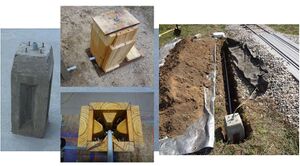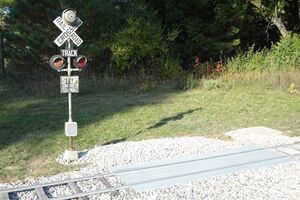Signals: Difference between revisions
Jump to navigation
Jump to search
| (5 intermediate revisions by the same user not shown) | |||
| Line 1: | Line 1: | ||
[[Category:Right of Way]] | [[Category:Right of Way]] | ||
== Signal Foundations == | |||
[https://www.chaski.org/homemachinist/viewtopic.php?t=110289 John Atkinson posted the following on <i>Chaski.org</i>]: | |||
: As you may already know, the subject of signal foundations falls into one of the elusive subject matters seldom if ever discussed within the miniature railroading hobby. | |||
: My research and observations along the way have formed the opinion that manufacturers of full-size signaling equipment also leave the requirements for the foundation to the engineering department of the railroad [itself] for determination. | |||
: I’m hazarding a guess the reason for this is because each installation calls for its own answer. | |||
: Clay in North Carolina verses sand in Northern Michigan to give an example. | |||
: Just for fun, I’ve taken the drawing of a [[Roll Models Industrial Railworks|RMI]] grade crossing signal and matched it to an actual foundation drawing for a full-size instrument case to provide a form of visual reference. It looks like the foundation required for the signal could be close to three feet in depth. | |||
: Does the foundation for the [[Roll Models Industrial Railworks|RMI]] signal need to be as robust as it appears in the screen shot? Probably not, but again… it would depend on where the signal was intended to be installed. | |||
: Last year I played around with making a foundation for installing a signal measuring 5 foot 8-1/2 inch tall. | |||
: Because I had previous reference material on how the signal had been mounted in the past, I made a guess and cast a couple of new foundations approximately 15 inches tall. The signal has been installed, has endured wind from passing storms etc, and is still standing. | |||
: For what it’s worth, the design feature of the below grade voids on all four sides of the foundation provides an exceptional gripping of the earth and should be implemented into your own ideas if you can. | |||
: Three pictures attached for reference. | |||
<gallery widths=300px heights=300px perrow=2> | |||
File:Atkinson SIGNAL FOUNDATION.JPG | |||
File:Atkinson FOUNDATION -1.JPG | |||
File:Atkinson Railroad Grade Crossing .jpg | |||
</gallery> | |||
== See Also == | == See Also == | ||
| Line 6: | Line 36: | ||
* [[Right Track Signals]] | * [[Right Track Signals]] | ||
* [[Hand signals]] | * [[Hand signals]] | ||
* [[Grade crossing]] | |||
* [[Semaphore Signal System for TMSRR]] | |||
== External Links == | == External Links == | ||
| Line 15: | Line 47: | ||
* [https://www.chaski.org/homemachinist/viewtopic.php?f=33&t=105960 "Signaling Beyond Simple Passing Sidings", <i>Chaski.org</i>] | * [https://www.chaski.org/homemachinist/viewtopic.php?f=33&t=105960 "Signaling Beyond Simple Passing Sidings", <i>Chaski.org</i>] | ||
* [https://www.jghtech.com/assets/applets/LFLSRM-Robinson-Normally-Closed%20-DC-Track-Circuit-Calculator-current.pdf "Robinson Normally Closed Direct Current Track Circuit", Jeffrey G. Hook, <i>Deerfield & Roundabout RR</i>] | * [https://www.jghtech.com/assets/applets/LFLSRM-Robinson-Normally-Closed%20-DC-Track-Circuit-Calculator-current.pdf "Robinson Normally Closed Direct Current Track Circuit", Jeffrey G. Hook, <i>Deerfield & Roundabout RR</i>] | ||
* [https://railroadsignals.us/signals/sem/index.htm <i>Railroad Signals of the U.S.</i>] | |||
* [https://www.slsls.asn.au/enthusiasts/wheel-track-and-signalling-standards/ "Wheel, Track and Signalling Standards", Sydney Live Steam Locomotive Society] | |||
Latest revision as of 13:46, 28 March 2023
Signal Foundations
John Atkinson posted the following on Chaski.org:
- As you may already know, the subject of signal foundations falls into one of the elusive subject matters seldom if ever discussed within the miniature railroading hobby.
- My research and observations along the way have formed the opinion that manufacturers of full-size signaling equipment also leave the requirements for the foundation to the engineering department of the railroad [itself] for determination.
- I’m hazarding a guess the reason for this is because each installation calls for its own answer.
- Clay in North Carolina verses sand in Northern Michigan to give an example.
- Just for fun, I’ve taken the drawing of a RMI grade crossing signal and matched it to an actual foundation drawing for a full-size instrument case to provide a form of visual reference. It looks like the foundation required for the signal could be close to three feet in depth.
- Does the foundation for the RMI signal need to be as robust as it appears in the screen shot? Probably not, but again… it would depend on where the signal was intended to be installed.
- Last year I played around with making a foundation for installing a signal measuring 5 foot 8-1/2 inch tall.
- Because I had previous reference material on how the signal had been mounted in the past, I made a guess and cast a couple of new foundations approximately 15 inches tall. The signal has been installed, has endured wind from passing storms etc, and is still standing.
- For what it’s worth, the design feature of the below grade voids on all four sides of the foundation provides an exceptional gripping of the earth and should be implemented into your own ideas if you can.
- Three pictures attached for reference.
See Also
External Links
- "The Viability of Solid-State Components for Signal Systems", Chaski.org
- "Searchlight signal build", Chaski.org
- "Track Circuit Occupancy Detection", Chaski.org
- "The Viability of Solid-State Components for Signal Systems", Chaski.org
- "Signaling Beyond Simple Passing Sidings", Chaski.org
- "Robinson Normally Closed Direct Current Track Circuit", Jeffrey G. Hook, Deerfield & Roundabout RR
- Railroad Signals of the U.S.
- "Wheel, Track and Signalling Standards", Sydney Live Steam Locomotive Society


